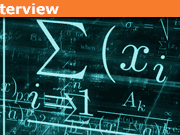Interview with Physicist David Hestenes
 For those who don’t know the great David Hestenes, he is the inventor of the geometric algebra formalism of physics. Here we go!
For those who don’t know the great David Hestenes, he is the inventor of the geometric algebra formalism of physics. Here we go!
Table of Contents
1) What is the best application of geometric algebra in theoretical physics that you can think of? In other words, what application shows the power and elegance of geometric algebra best?
The single most striking feature of Geometric Algebra (GA) is that it reduces electrodynamics to a single (relativistically invariant) “Maxwell’s equation:”
DF = J,
where F is the electromagnetic field, J is the charge current density and the differential operatorD turns out to be the same as the “Dirac operator” when the Dirac equation is formulated in GA.
Furthermore, when an inertial frame is selected, GA easily splits this single equation into the familiar set of four “Maxwell equations” formulated in standard vector algebra.
2) What are the best sources for physicists and graduate students to learn about geometric algebra and its applications?
These days the internet is the best resource for getting up to speed on just about anything. For GA the websites at Arizona State University [GA-ASU] and Cambridge University [GA-CamU] are recommended:
[GA-ASU]: http://geocalc.clas.asu.edu/
[GA-CamU]: http://geometry.mrao.cam.ac.uk/
A comprehensive overview of GA in physics is given in a three paper follow-up to my 2002 Oersted Medal Lecture at [GA-ASU]:
Reforming the Mathematical Language of Physics,
Spacetime Physics with Geometric Algebra,
Gauge Theory Gravity with Geometric Calculus.
Geometric Calculus (GC) is an extension of GA to include differentiation in the same sense that Vector Calculus, which it generalizes, is an extension of Vector Algebra.
3) Do you think undergrad students in physics should be taught geometric algebra? If so, can you recommend a good book for them?
Yes, but for introductory physics it should probably wait until someone writes a GA-based textbook. Some advantages of GA at this level are demonstrated in a GA Primer, available at [GA-ASU].
For advanced undergraduates I have written a textbook:
New Foundations for Classical Mechanics (1986) now published by Springer.
It contains the most thorough introduction to GA available anywhere, with many examples and exercises. It is the only mechanics book using completely coordinate-free methods. In particular, it employs spinors in extensive treatments of rotations, rotational dynamics and celestial mechanics without matrices, thus demonstrating that spinors are as useful in classical mechanics as they are in quantum mechanics. For anyone who wants to master GA through independent study, I recommend this book. Unfortunately, it is still exorbitantly priced, though thousands of copies have been sold.
4) Likewise, can you give some recommendations for more experienced physicists who would like to use the formalism of geometric algebra? Some kind of geometric algebra book for people who are already used to the language of forms and tensors?
A comprehensive treatment of GA for physicists is given in the book: Geometric Algebra for Physicists by Chris Doran and Anthony Lasenby, Cambridge U. Press. Slides for a lecture course on GA are available at [GA-CamU].
The book that started it all in 1966, Space Time Algebra, is still useful as a compact introduction for physicists. It has been reprinted in a second edition by Springer (2015) with a forward by Anthony Lasenby.
5) Can pure mathematicians benefit in learning geometric algebra? That is, if you’re interested in only mathematics by itself, is it still worth it?
Certainly. The evolution of GA is firmly grounded in the history of mathematics, especially in the seminal work if Hermann Grassmann, as documented in [GA-ASU]. Already GA and GC unifies a broader range of mathematics than any other mathematical system, and, of course, it facilitates applied mathematics through its close connections to physics. An extensive treatment of mathematical foundations is given in the monograph:
Clifford Algebra to Geometric Calculus, a unified language for mathematics and physics by D. Hestenes and G. Sobczyk (1984), now published by Springer.
This work provided an essential foundation for Gauge Theory Gravity (See [GA-CamU]).
6) What are the main advantages that geometric calculus has over differential forms? Should one learn differential forms if geometric calculus is superior?
With only minor adjustments in notation, GC generalizes the standard theory of differential forms to include spinor and tensor fields. It reduces differential and integral calculus on manifolds to properties of a single differential operator D, a natural generalization of the Dirac operator already recognized as fundamental in Maxwell’s equation.
7) Geometric algebra has found many applications. I have even seen applications in programming. Did you expect this kind of success? Are there any other unexpected applications that will be developed in the near future?
A big surprise came in 2000 with the formulation of Conformal Geometric Algebra, which enables direct composition and intersection of points, lines, planes and spheres. This proved to be a boon to computer graphics, as explained in the book:
Geometric Algebra for Computer Science: an object oriented approach to geometry,
by L.Dorst, D.Fontijne and S.Mann, Morgan Kaufman publishers 2007.
Many people are now involved in creating software for GA computing.
8) Various different authors use very different formulations and terminology of geometric algebra. Case in point, the mathematicians prefer the term Clifford algebra or analysis, while physicists prefer some other names. How does one deal with these different formulations? Is there some kind of canonical reference or Rosetta Stone to deal with this?
Virtually anyone who prefers the term “Clifford algebra” to “Geometric algebra” is unaware of the power and broader range of applications given to GA by its various geometric interpretations. That is abundantly clear in the GA references already cited.
9) Do you think Geometric algebra would give a new perspective on quantum gravity that is not captured by current approaches?
Quantum gravity is not a subject but a problem: namely, to reconcile quantum mechanics, which is grounded in energy-momentum conservation laws, with General Relativity, which does not recognize those laws. I think the best shot at resolving this problem is with the GA-based Gauge Theory Gravity, already mentioned above.
10) What do you feel is the main problem with high school teaching of physics nowadays? How do you propose to solve this?
The main problem is to empower teachers already in the classroom with (1) professional support from a community of colleagues animated by (2) a common vision of good teaching, and (3) scientific support from physics departments in nearby colleges and universities.
I am pleased to report that the essential mechanism for a nationwide solution has already been created by physics teachers themselves, namely a community of practice called the American Modeling Teachers Association, with a membership or more than 2000. Each summer the AMTA organizes and conducts nearly 100 STEM teaching workshops for more than 2000 inservice teachers nationwide. The AMTA is a partner with the AAPT and has been formally recognized for the quality of its service by the APS 2014 Excellence in Physics Education Award. Unfortunately, as I opine in an AJP editorial (Am. J. Phys. 83 (2), February 2015), the AMTA has not received the support it needs and deserves from the physics community to drive rapid, deep and sustained STEM education reform for the nation.
11) Can you tell us a bit about Modeling Theory in education? How does it work? Where can interested teachers learn about it? Do you think it has been successful so far?
The Modeling Method of Instruction (adopted by the AMTA) has three basic elements: (1) course content is organized around a small set of basic scientific models; (2) students are introduced to each model through an instructional cycle that engages them in all aspects of formulating the model theoretically, testing it empirically and defending their conclusions with argument and evidence; (3) teachers guide students through each cycle with “modeling discourse” that is informed by difficulties that students may encounter and subtly directs their attention to salient points.
Foundations for a Modeling Theory of Cognition and Instruction are discussed in papers available in the Modeling section of [GA-ASU].
Read the next interview with physicist David J. Griffiths
I have a BS in Information Sciences from UW-Milwaukee. I’ve helped manage Physics Forums for over 22 years. I enjoy learning and discussing new scientific developments. STEM communication and policy are big interests as well. Currently a Sr. SEO Specialist at Shopify and writer at importsem.com








[QUOTE="stevendaryl, post: 5591579, member: 372855"]Geometric algebra also is a research program leading toward a new interpretation of complex numbers in physics. I don't actually think anything much has come of this research program, but it's kind of interesting. The geometric algebra approach tends to look for geometric reasons for the appearance of complex numbers in the mathematics of physics. Often when the imaginary number [itex]i[/itex] appears, it can be reinterpreted as a geometric object whose square is negative: pseudo-scalars or bi-vectors. After-the-fact, the Pauli equation can be derived from the Schrodinger equation by interpreting the [itex]i[/itex] as a bivector.”Of course, tastes differ, but I don't think this is a strong point of geometric algebra. I prefer the approach of Schroedinger (Nature, 169:538, 1952), who noted that, say, in the Klein-Gordon equation, the wave function can be made real by a gauge transform. After that, you just don't have any complex numbers (or pairs of real numbers), just real numbers. Using a similar, but a more complex trick, one can get rid of complex numbers in the Dirac equation (http://akhmeteli.org/wp-content/uploads/2011/08/JMAPAQ528082303_1.pdf, published in the Journal of Mathematical Physics).
[QUOTE="Demystifier, post: 5593013, member: 61953"]That leads me to a question. Suppose that [itex]gamma^{mu}[/itex] are only basis vectors, and nothing more. Then all what matters is their algebra$$gamma^{mu}gamma^{nu}+gamma^{nu}gamma^{mu}=2g^{munu}$$while the the representation in terms of matrices, or even the dimension ##d## of the representation (which, in 4 spacetime dimensions, must be ##dgeq 4##) should be irrelevant. But without any information about the representation (including ##d##) it seems impossible to extract all the relevant physical information from the Dirac equation. For instance, it seems impossible to find the spectrum of the relativistic hydrogen atom. Doesn't it suggest that physics requires a representation, and consequently, that [itex]gamma^{mu}[/itex] are more than basis vectors?”Well, the anti-commutation relations for gamma-matrices contain the metric tensor, which provides information on the dimension of the spacetime:-). But I certainly agree that the Dirac equation contains more than just gamma-matrices. For one, it contains a 4-spinor. According to Cartan, 4-spinors are pretty much equivalent to pairs of isotropic bivectors (an isotropic bivector in the Minkowski space is like an electromagnetic field with zero invariants E^2-H^2 and EH). I would also like to add that Cartan treats gamma-matrices both as vectors and reflections represented by the vectors. So, for example, the product of a gamma-matrix and a spinor (in this order) is a spinor which is a reflection of the original spinor.
[QUOTE="stevendaryl, post: 5592322, member: 372855"]It seems to me that the geometric algebra approach provides a very different interpretation of the Dirac gamma matrices. Most people treat the gamma matrices [itex]gamma^nu[/itex] as either (1) 4 components of a matrix-valued 4-vector, or (2) four constant matrices. The geometric algebra views the gamma matrices as 4 basis vectors. So it's 4 vectors, rather than 4 components of one (matrix-valued) vector. That doesn't seem to me to just be a matter of notation.”I think treating gamma-matrices as basis vectors is useful and important. However, such treatment was heavily used already in the book "Theory of spinors" by E. Cartan, the discoverer of spinors. This book was first published in 1938. Cartan also treats products of 2 gamma-matrices as so called bivectors (2-dimensional planes) etc.
[QUOTE="stevendaryl, post: 5591579, member: 372855"]he occurrence of mixed objects that are linear combinations of scalars, vectors, and tensors. That's not something that makes much sense from the point of view of the traditional approach.”Well, one can consider $Rtimes R^2times R^{2times 2}$ and has linear combinations of them all, in a traditional vector space. Continuing with tensors of higher order and restricting to the symmetric or alternating case, one ends up with traditional Fock spaces. Thus linear combinations of scalars, vectors and tensors (and even spinors) are known and used since 1930.
[USER=61953]@Demystifier[/USER], Hestenes's spacetime algebra [itex]G_{1,3}[/itex] is generated from the Minkowski space [itex]mathbb{R}_{1,3}[/itex]. To say that the [itex]gamma^mu[/itex] are only basis vectors is usually meant to clarify that, in [itex]G_{1,3}[/itex], they are simply a basis for [itex]mathbb{R}_{1,3}[/itex] and that they are meant to be thought of as such.
Also, what about the intertwiner in the Dirac bilinear? Once you take away the matrix notation, the intertwiner "comes out of the woodwork", and all kinds of Personal Theory questions come up. (I can't say what these questions are, of course, but it should be obvious what I'm getting at.)
[QUOTE="stevendaryl, post: 5592322, member: 372855"]It seems to me that the geometric algebra approach provides a very different interpretation of the Dirac gamma matrices. Most people treat the gamma matrices [itex]gamma^nu[/itex] as either (1) 4 components of a matrix-valued 4-vector, or (2) four constant matrices. The geometric algebra views the gamma matrices as 4 basis vectors. So it's 4 vectors, rather than 4 components of one (matrix-valued) vector. That doesn't seem to me to just be a matter of notation.”That leads me to a question. Suppose that [itex]gamma^{mu}[/itex] are only basis vectors, and nothing more. Then all what matters is their algebra$$gamma^{mu}gamma^{nu}+gamma^{nu}gamma^{mu}=2g^{munu}$$while the the representation in terms of matrices, or even the dimension ##d## of the representation (which, in 4 spacetime dimensions, must be ##dgeq 4##) should be irrelevant. But without any information about the representation (including ##d##) it seems impossible to extract all the relevant physical information from the Dirac equation. For instance, it seems impossible to find the spectrum of the relativistic hydrogen atom. Doesn't it suggest that physics requires a representation, and consequently, that [itex]gamma^{mu}[/itex] are more than basis vectors?
It seems to me that the geometric algebra approach provides a very different interpretation of the Dirac gamma matrices. Most people treat the gamma matrices [itex]gamma^nu[/itex] as either (1) 4 components of a matrix-valued 4-vector, or (2) four constant matrices. The geometric algebra views the gamma matrices as 4 basis vectors. So it's 4 vectors, rather than 4 components of one (matrix-valued) vector. That doesn't seem to me to just be a matter of notation.
[QUOTE="Demystifier, post: 5591940, member: 61953"]I would compare it with introducing a 4-vector notation in non-relativistic physics. E.g. a plane-wave solution of the non-relativistic Schrodinger equation can be written as ##exp(ik_{mu}x^{mu})## where ##mu=0,1,2,3##, ##x^0=t## is time and ##k_0=omega## is frequency. It simplifies the notation, but does not have a deeper physical content in non-relativistic physics.”I would argue that a 4-vector notation would provide a clearer link showing how non-relativistic physics is a limiting case of relativistic physics. That was the motivation for formulating Newtonian gravity from a space time viewpoint (Cartan, Trautman, Ehlers, …).One could imagine that if one had somehow formulated non-relativistic physics in this way… the leap to relativistic physics may have been simpler.I think things like vectors, tensors, differential forms, spinors, geometric-algebra, etc… provide more than a compact notation. They seem to display symmetries that may not be evident in (say) component form. One can think of a geometrical object, rather than merely a collection of components that transform in certain ways.
[QUOTE="stevendaryl, post: 5591579, member: 372855"]It's hard to say whether it provides new insight, or is just a matter of notation. The interesting thing about geometric algebra, compared to the usual mathematics of tensors, is the occurrence of mixed objects that are linear combinations of scalars, vectors, and tensors. That's not something that makes much sense from the point of view of the traditional approach.”I would compare it with introducing a 4-vector notation in non-relativistic physics. E.g. a plane-wave solution of the non-relativistic Schrodinger equation can be written as ##exp(ik_{mu}x^{mu})## where ##mu=0,1,2,3##, ##x^0=t## is time and ##k_0=omega## is frequency. It simplifies the notation, but does not have a deeper physical content in non-relativistic physics.
[QUOTE="Demystifier, post: 5590949, member: 61953"]My impression is that geometric algebra is just a more compact notation for objects which are usually written in terms of tensors or spinors. A compact notation may be useful, but it's rarely essential.”It's hard to say whether it provides new insight, or is just a matter of notation. The interesting thing about geometric algebra, compared to the usual mathematics of tensors, is the occurrence of mixed objects that are linear combinations of scalars, vectors, and tensors. That's not something that makes much sense from the point of view of the traditional approach.Geometric algebra also is a research program leading toward a new interpretation of complex numbers in physics. I don't actually think anything much has come of this research program, but it's kind of interesting. The geometric algebra approach tends to look for geometric reasons for the appearance of complex numbers in the mathematics of physics. Often when the imaginary number [itex]i[/itex] appears, it can be reinterpreted as a geometric object whose square is negative: pseudo-scalars or bi-vectors. After-the-fact, the Pauli equation can be derived from the Schrodinger equation by interpreting the [itex]i[/itex] as a bivector.
Thanks @micromass for this great Interview!
My impression is that geometric algebra is just a more compact notation for objects which are usually written in terms of tensors or spinors. A compact notation may be useful, but it's rarely essential.
I think it is more correct to refer to David Hestenes as a physicist… maybe mathematical physicist (although he is also involved in physics education research [Force-Concept Inventory and Modeling Instruction]).But "mathematician" alone neglects the "Physics" side.His PhD is in Physics http://adsabs.harvard.edu/abs/1963PhDT……..27HHis mailing address is in the Physics Department at ASU.His title is "Professor Emeritus" in the Physics department http://physics-dev.asu.edu/home/people/emeritus-faculty/david-hestenes